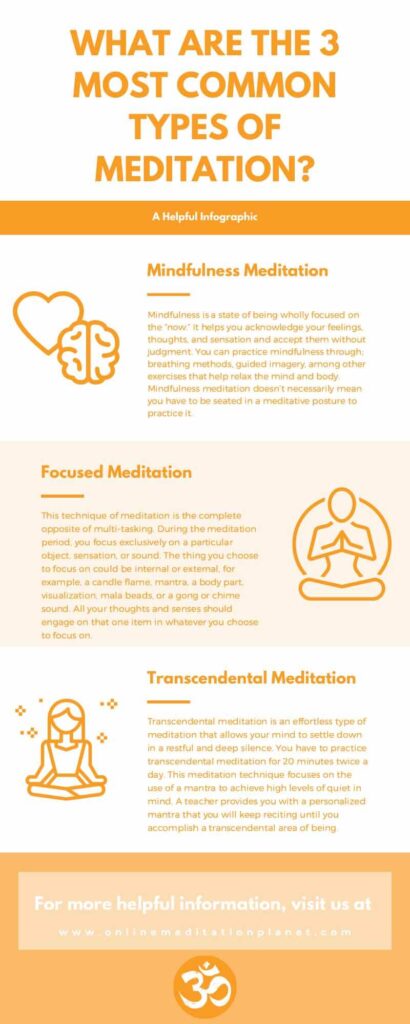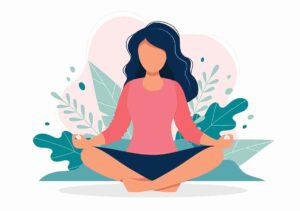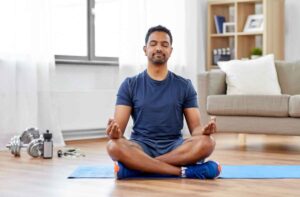In our daily lives, we encounter situations where we are unable to control a lot of things. Most times, this can result in a lot of stress, anxiety, and depression. Meditation can help us avoid all this by learning how to control the little we can (such as our breaths) and give the mind a little rest from thinking all the time. There are three main types of meditation techniques that we will cover that research has shown help with stress and anxiety.
Meditation is an ancient practice primarily used in a religious setting. Meditation is a set of techniques that help us focus on improving awareness, compassion, and attention. Meditation doesn’t make you turn off your feelings or thoughts but instead enables you to observe them without judgment. As you keep practicing, you’ll better understand your feelings, thoughts, and actions.
Meditation doesn’t make you a better person or a new person, but it instead helps you understand yourself better. The more you engage in a particular type of meditation practice, the more you’ll be able to learn the patterns and habits of your mind. You will eventually learn more positive ways of thinking and living just by practicing.
Article Contents
Where Did Meditation Originate From?
While it’s only recently that meditation has gained popularity, it has been around for thousands of years. In India, it is part of the ayurvedic practices while also part of the traditional medical practices of both Japan and India. Other religions like; Judaism, Jainism, Sikhism, and Buddhism also practiced meditation. The practice only became part of every different culture in the 20th century.
The earliest written records of meditation are from India, which date back to 1500 BCE. Before then, it is possible that meditation was passed down to generations by ancestors through word of mouth.
Scientific research into the benefits of meditation only began in the 1960s. When researchers discovered that some yogis could meditate into deep trances, even pressing hot test tubes against their arms couldn’t get them out of the trance. During this time, “hippies” started practicing it, and it rose in the western culture.
Over the last few years, meditation has been used to treat stress, anxiety, depression, and other mental conditions. As its benefits began being backed up by research.
How Many Different Types of Meditations are There?
There are around nine types of meditation techniques commonly practiced around the world. These meditation techniques fall into two categories;
● Guided
Guided meditation is primarily suitable for beginners. A teacher guides you through what you should do. This practice can either be through a meditation app or in-person. The teacher explains how this practice works, then guides you through it and recommends when you should do it throughout your day to get the most out of it.
● Unguided
This form of meditation could either involve you sitting silently in a room and meditating. Or it can mean you are practicing a form of meditation practice that you know.
There are nine types of meditation techniques that fall under these two categories. They can all be practiced, either guided or unguided, depending on the technique and experience level.
1. Metta/loving-kindness meditation
Metta meditation involves bringing awareness of people in your life and sending positive energy and thoughts towards them and yourself. It helps reduce anger and increase compassion and positivity.
2. Mantra Meditation
In mantra meditation, all your concentration is focused on a word, phrase, or syllable. This type of meditation is suitable for hard days when you can’t concentrate on your meditation. After repeating your ‘matra’ for a while, your level of concentration and presence increases.
3. Spiritual Meditation
Spiritual meditation includes reflecting on the silence around you and seeking a deeper connection to your creator. In this meditation, you believe that there’s something greater out there and seeking a relationship with it.
4. Transcendental Meditation
In this practice, you use a given set of words or matra, and you sit down daily for 20 minutes twice a day and meditate. This meditation aims to raise you above your current state of being.
5. Mindfulness Meditation
Also known as present-moment meditation is when you are fully present with your thoughts and feelings and not judging or engaging with them. You can do this seated down in a quiet place or wherever you feel most comfortable.
6. Progressive Relaxation/Body Scan Meditation
This form of meditation encourages people to scan their bodies, usually starting with one area like feet and going all the way to the head. As you go through every part of the body, you relax that part. It helps release tension in the body.
7. Focused Meditation
In this form of meditation, you can use any object (i.e., counting mala beads, watching a candle flame) and focus on it exclusively. This method helps train your mind to become more focused.
8. Yoga Meditation
You can bring your meditative concentration and awareness to your yoga practice by focusing on your breathing and the present.
9. Visualization Meditation
Visualization meditation helps an individual picture relaxing scenes and images that helps them relax. Using all fice sense in this practice helps in boosting the vividness of the imagery.
1. Mindfulness Meditation
Mindfulness is a state of being wholly focused on the “now.” It helps you acknowledge your feelings, thoughts, and sensation and accept them without judgment. You can practice mindfulness through; breathing methods, guided imagery, among other exercises that help relax the mind and body.
Mindfulness meditation doesn’t necessarily mean you have to be seated in a meditative posture to practice it. If you’re a busy person, you can incorporate it into your daily activities.
How To Practice
- Sitting meditation. You can sit in a meditative posture or sit on a chair with your legs flat on the ground and place your hands on your lap. Fix your attention on the breath getting in and leaving your body. You might get carried away by activities around you or thoughts, but you can always come back to your breath. Take a note of the activities causing interference each time.
- Body scan meditation. You can lie down on your back with your legs extended and your arms by your side, palms facing up (savasana pose). Focus all your body parts as you go through it from head to toe or vice versa. Be aware of emotions and sensations associated with each part of your body.
- Walking meditation. Find a quiet palace and begin walking around an area of between 10-20 feet. As you walk, concentrate on the feelings of support you get from your feet and the sensations that arise from walking. As you approach the end of your path, turn back and keep walking.
How often should you practice mindfulness meditation?
Well, this depends on the amount of time you have available. When it comes to the seated and body scan meditation, set aside a time of day when it is quiet, and you won’t have any interferences. The walking meditation is most enjoyable when done in nature.
2. Focused Meditation
This technique of meditation is the complete opposite of multi-tasking. During the meditation period, you focus exclusively on a particular object, sensation, or sound. The thing you choose to focus on could be internal or external, for example, a candle flame, mantra, a body part, visualization, mala beads, or a gong or chime sound. All your thoughts and senses should engage on that one item in whatever you choose to focus on.
How To Practice
If you’re a beginner, you’re encouraged to start with between 5-10 minutes as your focus grows because, in the beginning, it can be a little challenging. Practicing at a time that you’re most comfortable with prevents it from being too hard.
- Pick a focus object. As a beginner, choosing to focus on your breath can be an excellent way to start. While focusing on your breathing, you can select a visual object, matra, or sensation to focus on.
- Fix your posture. After picking an object of focus, sit in the correct position with your back straight (but not stiff). If seated on a chair, make sure both feet are flat on the ground. Make sure you don’t lean forwards.
- Relax your body. You can do this by breathing deeply into your belly. Make sure that parts of your body aren’t stiff.
- Focus on your object. Now, focus all your senses on the object in front of you. Control your thoughts so that you don’t think about anything other than experiencing the sensations in the present moment. For example, if you’re focusing on breathing, think about how breathing affects your body and the sensations coursing through you as you inhale and exhale.
- Quiet your mind. This task is the hardest of all as we always have something running through our minds. Any time thoughts interrupt you, keep going back to your point of focus and keep the mind silent.
- Keep practicing. Even though concentrating at first can be challenging, don’t beat yourself up. The more you practice, the better you will get.
3. Transcendental Meditation
Transcendental meditation is an effortless type of meditation that allows your mind to settle down in a restful and deep silence. You have to practice transcendental meditation for 20 minutes twice a day. This meditation technique focuses on the use of a mantra to achieve high levels of quiet in mind. A teacher provides you with a personalized mantra that you will keep reciting until you accomplish a transcendental area of being.
The most notable difference between transcendental meditation and other forms of meditation is the mantra you repeat during your session.





